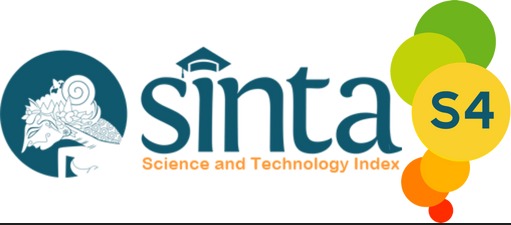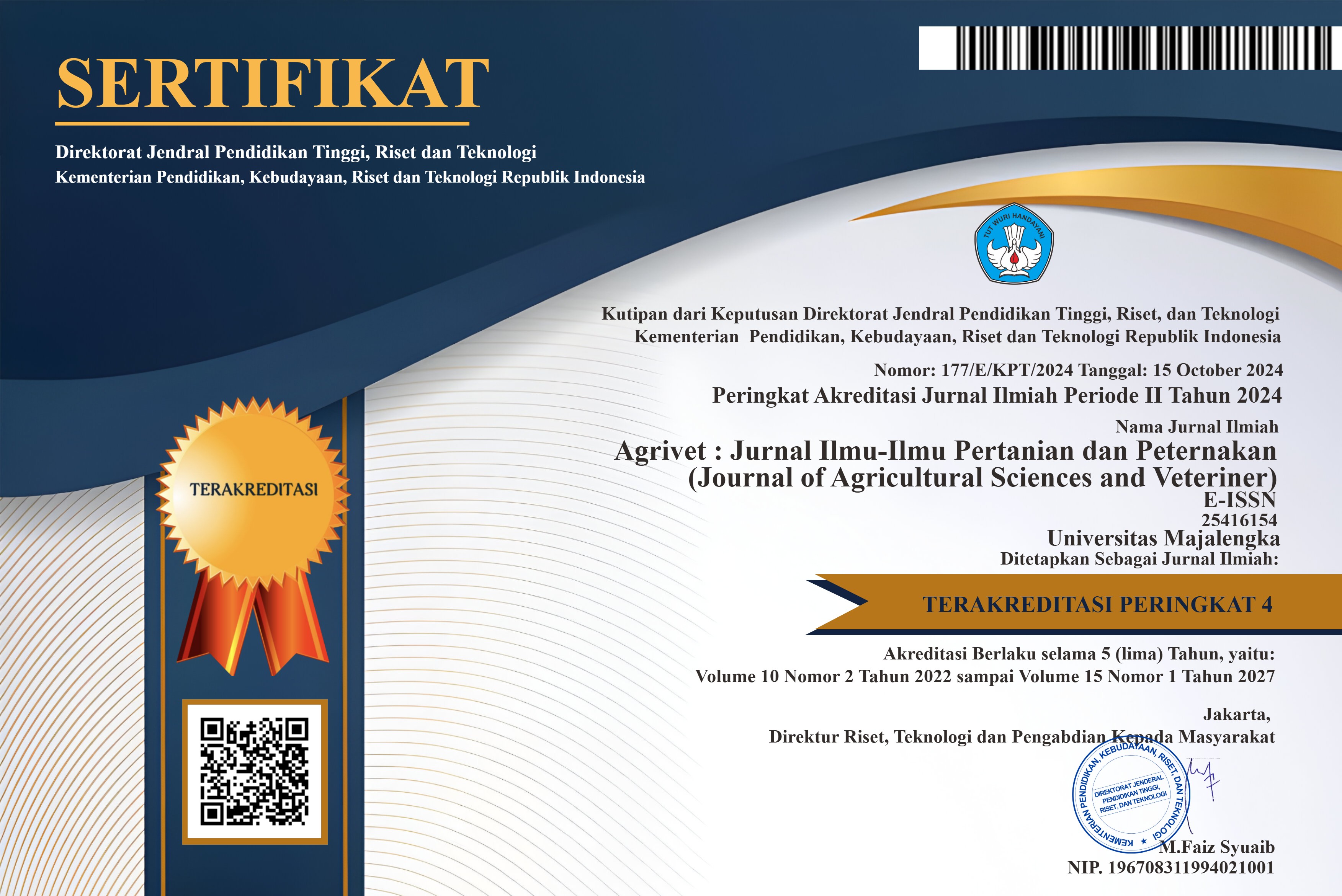Qualitative Traits of Muscovy duck (Cairina moschata) in Ciayumajakuning, West Java, Indonesia
DOI:
https://doi.org/10.31949/agrivet.v10i2.3768Abstract
Qualitative traits can be used as a reference for entog development and conservation. Qualitative traits are indispensable for selection based on phenotypics such as plumage color, beak color, and shank color. The research objective was studied the qualitative traits of entog in Ciayumajakuning (Cirebon, Indramayu, Majalengka, dan Kuningan). This research uses survey method with sampling technique of multistage probability random sampling. The research object observed are 673 Muscovy ducks consisting of 309 drake and 364 duck. Data analysis applies descriptive qualitative analysis method. The results of research show that duck Muscovy ducks plumage colors are dominated by black and white (44.78%), only white (28.30%), and only black (17.86%); while drake are dominated by only white (45%), black and white (35.9%), and gray (7, 77%). The duck beak colors are dominated by black (25.82%), black and white (20.60%), and pink (23.63%); while drake beak colors include pink (38.80%), black (21.00%), and black and white (19.40%). Duck shank colors are dominated by black (39.29%), white (27.29%), and yellow (18.68%); while drake shank colors, among others, are yellow (41.70%), black (29.80%), black and white (12.00%). Based on the results of the study, it can be concluded that the qualitative traits of Muscovy duck in Ciayumajakuning are quite diverse.
Keywords:
mating behavior, Muscovy duck, CiayumajakuningDownloads
References
Abd El-Samee, L. D., El-Allawy, H. M. H., & Maghraby, N. A. (2012). Comparative study on some productive traits of Muscovy and Sudani ducks in Egypt. International Journal of Poultry Science. https://doi.org/10.3923/ijps.2012.264.268
Banga-Mboko, H., Lelou, B., Maes, D., & Leroy, P. L. (2007). Indigenous Muscovy Ducks in Congo Brazzaville. 2. Preliminary observations on indigenous Muscovy ducks reared under moderate inputs in Congolese conditions. Tropical Animal Health and Production. https://doi.org/10.1007/s11250-007-4235-0
Bati, J., Biza-Koukaba, C., Banga-Mboko, H., Mfoukou-Ntsakala, A., Bakoutana, D., Adzona, P., Hornick, J., & Leroy, P. (2014). Phenotypic Characterization According to The Feather Color of Indigenous Muscovy Ducks Bred in The Back Yard in Brazzaville, The Congo. ANIMAL PRODUCTION. https://doi.org/10.20884/1.anprod.2014.16.3.459
Briese, A., Hänscn, F., & Hartung, J. (2009). Wasserangebote für moschusenten - Verhalten von moschusenten an “entenduschen” und modifizierten plassontränken. Berliner Und Munchener Tierarztliche Wochenschrift. https://doi.org/10.2376/0005-9366-122-302
Brun, J. M., Richard, M. M., Marie-Etancelin, C., Rouvier, R., & Larzul, C. (2005a). Le canard mulard: Déterminisme génétique d’un hybride intergénérique. Productions Animales. https://doi.org/10.20870/productions-animales.2005.18.5.3534
Brun, J. M., Richard, M. M., Marie-Etancelin, C., Rouvier, R., & Larzul, C. (2005b). The mule duck: Genetic determinism of an intergeneric hybrid. Productions Animales.
Chen, S., Lin, F., Chen, S., Hu, Q., Cheng, X., Jiang, B., Zhu, X., Wang, S., Zheng, M., & Huang, M. (2018). Development of a live attenuated vaccine against Muscovy duck reovirus infection. Vaccine. https://doi.org/10.1016/j.vaccine.2018.10.102
Cheng, Y. S., Rouvier, R., Poivey, J. P., Tai, J. J. L., Tai, C., & Huang, S. C. (2002). Selection responses for the number of fertile eggs of the Brown Tsaiya duck (Anas platyrhynchos) after a single artificial insemination with pooled Muscovy (Cairina moschata) semen. Genetics Selection Evolution. https://doi.org/10.1051/gse:2002025
Chung, E. L. T., Reduan, M. F. H., Nordin, M. L., Abdullah, F. F. J., Zairi, N. H. M., Rajdi, N. Z. I. M., Kamaruzaman, I. N. A., & Shaharulnizim, N. (2020). A case of aspergillosis outbreak in a broiler duck farm in Kelantan, Malaysia. Journal of Advanced Veterinary and Animal Research. https://doi.org/10.5455/javar.2020.g469
Damaziak, K., Michalczuk, M., Adamek, D., Czapliński, M., Niemiec, J., Goryl, A., & Pietrzak, D. (2014). Influence of housing system on the growth and histological structure of duck muscles. South African Journal of Animal Sciences. https://doi.org/10.4314/sajas.v44i2.1
Dash, S., & Mohanty, P. K. (2002). A study on the avian fauna in captivity at Nandankanan Zoological Park, Orissa. Zoos’ Print Journal.
Drouilhet, L., Monteville, R., Molette, C., Lague, M., Cornuez, A., Canario, L., Ricard, E., & Gilbert, H. (2016). Impact of selection for residual feed intake on production traits and behavior of mule ducks. Poultry Science. https://doi.org/10.3382/ps/pew185
El-Tholoth, M., Hamed, M. F., Matter, A. A., & Abou EL-Azm, K. I. (2019). Molecular and pathological characterization of duck enteritis virus in Egypt. Transboundary and Emerging Diseases. https://doi.org/10.1111/tbed.13002
Etuk, I. F., Ojewola, G. S., & Abasiekong, S. F. (2006). Performance of muscovy ducks under three management systems in South Eastern Nigeria. International Journal of Poultry Science. https://doi.org/10.3923/ijps.2006.474.476
Etuk, Idorenyin Friday, Ojewola, G. S., Abasiekong, S. F., Amaefule, K. U., & Etuk, E. B. (2012). Calidad de los huevos de los patos muscovy criados bajo diferentes sistemas de manejo en los trópicos húmedos. Revista Cientifica UDO Agricola.
Ewuola, M. K., Akinyemi, M. O., Hassan, W. A., & Folaniyi, B. S. (2020). Morphological Diversity of Muscovy Duck in Humid Zone of Nigeria. Journal of Agriculture and Ecology Research International. https://doi.org/10.9734/jaeri/2020/v21i230131
Guémené, D., Guy, G., Mirabito, L., Servière, J., & Faure, J. M. (2007). Bien-être et élevage des palmipèdes. In Productions Animales. https://doi.org/10.20870/productions-animales.2007.20.1.3435
Gustafson, L. A., Cheng, H. W., Garner, J. P., Pajor, E. A., & Mench, J. A. (2007). Effects of bill-trimming Muscovy ducks on behavior, body weight gain, and bill morphopathology. Applied Animal Behaviour Science. https://doi.org/10.1016/j.applanim.2006.04.003
Kiple, K. F., & Ornelas, K. C. (2001). The Cambridge World History of Food. Food Service Technology. https://doi.org/10.1046/j.1471-5740.2001.00006.x
Liu, H. C., Huang, J. F., Lee, S. R., Liu, H. L., Hsieh, C. H., Huang, C. W., Huang, M. C., Tai, C., Poivey, J. P., Rouvier, R., & Cheng, Y. S. (2015). Selection for duration of fertility and mule duck white plumage colour in a synthetic strain of ducks (Anas platyrhynchos ). Asian-Australasian Journal of Animal Sciences. https://doi.org/10.5713/ajas.14.0740
Liu, Z., Li, M., Yan, P., Zhu, Z., Liao, L., Chen, Q., Luo, Y., Li, H., Li, J., Wang, Q., Huang, Y., & Wu, Y. (2019). Transcriptome analysis of the effects of Hericium erinaceus polysaccharide on the lymphocyte homing in Muscovy duck reovirus-infected ducklings. International Journal of Biological Macromolecules. https://doi.org/10.1016/j.ijbiomac.2019.08.130
Lyu, W., Liu, X., Lu, L., Dai, B., Wang, W., Yang, H., & Xiao, Y. (2021). Cecal Microbiota Modulates Fat Deposition in Muscovy Ducks. Frontiers in Veterinary Science. https://doi.org/10.3389/fvets.2021.609348
Magalhães, B. S. N., Pereira, V. L. A., Machado, L. S., Dias, T. S., Balthazar, D. A., Barreto, M. L., Troccoli, F., Cunha, N. C., Nascimento, E. R., Almeida, F. M., & Almosny, N. R. (2020). Occurrence of avian mycoplasmas in free-living Muscovy-ducks (Cairina moschata). Revista Brasileira de Ciencia Avicola. https://doi.org/10.1590/1806-9061-2020-1352
Marie-Etancelin, C., Chapuis, H., Brun, J. M., Larzul, C., Mialon-Richard, M. M., & Rouvier, R. (2008). Genetics and selection of mule ducks in France: A review. In World’s Poultry Science Journal. https://doi.org/10.1017/S0043933907001791
Marzoni, M., Chiarini, R., Castillo, A., Romboli, I., De Marco, M., & Schiavone, A. (2014). Effects of dietary natural antioxidant supplementation on broiler chicken and Muscovy duck meat quality. Animal Science Papers and Reports.
Ogah, D. M., Alaga, A. A., & Momoh, M. O. (2009). Principal component factor analysis of the morphostructural traits of Muscovy duck. International Journal of Poultry Science. https://doi.org/10.3923/ijps.2009.1100.1103
Oguntunji, A.O., & Ayorinde, K. L. (2015). Phenotypic characterization of the Nigerian Muscovy Ducks (Cairina moschata). Animal Genetic Resources/Ressources Génétiques Animales/Recursos Genéticos Animales. https://doi.org/10.1017/s2078633614000472
Oguntunji, A.O., Oladejo, O. A., & Ayorinde, K. L. (2015). Seasonal variation in egg production and mortality of Muscovy ducks (Cairina Moschata). Biotechnology in Animal Husbandry. https://doi.org/10.2298/bah1502181o
Oguntunji, Abel Olusegun. (2017). Regression tree analysis for predicting body weight of Nigerian muscovy duck (Cairina moschata). Genetika. https://doi.org/10.2298/GENSR1702743O
Raji, A. O., Igwebuike, J. U., & Usman, M. T. (2009). Zoometrical body measurements and their relation with live weight in matured local Muscovy ducks in Borno State, Nigeria. ARPN J Agric Biol Sci.
Schaaf, A. A., Gomez, D., Tallei, E., Rivera, L. O., Politi, N., & Cuyckens, G. A. E. (2018). Assessing distribution and conservation potential for the muscovy duck (Cairina moschata) in argentina. Neotropical Biology and Conservation. https://doi.org/10.4013/nbc.2018.133.01
Tamzil, M. H., Lestari, L., & Indarsih, B. (2018). Measurement of several qualitative traits and body size of Lombok Muscovy Ducks (Cairina moshcata) in semi-intensive rearing. Mathematics of Operations Research. https://doi.org/10.14710/jitaa.43.4.333-342
Widianingrum, D., Widjastuti, T., Anang, A., & Setiawan, I. (2020). Technical characteristics of Muscovy duck (Cairina Moschata) in Ciayumajakuning, West Java Indonesia. Journal of Agricultural Sciences - Sri Lanka. https://doi.org/10.4038/jas.v15i2.8814
Yakubu, A. (2011). Discriminant analysis of sexual dimorphism in morphological traits of African Muscovy ducks. Archivos de Zootecnia. https://doi.org/10.4321/s0004-05922011000400027
Yakubu, A. (2013). Characterisation of the local Muscovy duck in Nigeria and its potential for egg and meat production. World’s Poultry Science Journal. https://doi.org/10.1017/S0043933913000937
Yakubu, & Ugbo, S. B. (2011). An assessment of biodiversity in morphological traits of Muscovy ducks in Nigeria using discriminant analysis. BIOLOGY, ENVIRONMENT AND CHEMISTRY.
Additional Files
Published
How to Cite
Issue
Section
License
Copyright (c) 2022 dini widianingrum

This work is licensed under a Creative Commons Attribution-ShareAlike 4.0 International License.
An author who publishes in the Jurnal Agrivet agrees to the following terms:
- Author retains the copyright and grants the journal the right of first publication of the work simultaneously licensed under the Creative Commons Attribution-ShareAlike 4.0 License that allows others to share the work with an acknowledgment of the work's authorship and initial publication in this journal
- The author is able to enter into separate, additional contractual arrangements for the non-exclusive distribution of the journal's published version of the work (e.g., post it to an institutional repository or publish it in a book) with the acknowledgment of its initial publication in this journal.
- The author is permitted and encouraged to post his/her work online (e.g., in institutional repositories or on their website) prior to and during the submission process, as it can lead to productive exchanges, as well as earlier and greater citation of the published work












